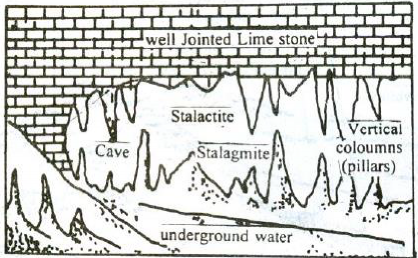11.2.1. Stalactites and Stalagmites
They are the major depositional features formed in the caverns in limestone regions. The water containing limestone in solution, seeps through the roofs of the caverns in the form of a continuous chain of drops. A portion of the water dropping from the ceiling gets evaporated and a small deposit of limestone is left behind on the roof. This process continues and deposit of limestone grows downwards like pillars. These forms are called stalactites.
When the remaining portion of the water dropping from the roof of the cavern falls on the floor, a part of it is again evaporated and a small deposit of limestone is left behind. This deposit grows upward from the floor of the cavern. These type of depositional features are called stalagmites. As the process grows, both stalactite and stalagmite often join together to form vertical columns and pillars in the caverns.

